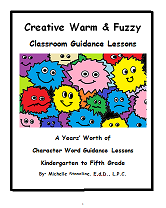Helping Kids Behave Part Seven
Teachers or parents will handle the situation to retain control of your classroom/home when and if he or she does do that particular thing. One needs to know his or her triggers to have a level playing field.
Ask yourself number of questions, such as, “Can I stay calm, cool and collected when a student curses me?” You may also find appendix A the self awareness interview helpful.
Monitor your self-control:
¨ Tune in to how you are communicating. Is your voice low and even? Do you make empathic statements? Are you being sarcastic or condescending?
¨ Are you letting yourself get drawn into an argument?
¨ Do you feel threatened?
¨ Is what the student is doing one of your “triggers”?
Gary Alderman (1998) has developed an excellent Self-awareness Inventory to help adults check their self-control (appendix A). It is recommend that one use it regularly to monitor his or her reactions.
For parents, what do you do when your child makes a major mistake. For instance is caught with drugs or becomes pregnant? Chapman (2000) has seven recommendations.
· Don’t blame yourself!
· Don’t preach.
· Don’t try to fix it or bail them out.
· Do give unconditional love.
· Do listen with empathy. (see the recommendations on listening above)
· Do give support.
· Do give guidance.
Thinking Feeling Behaving
Many at risk kids can’t distinguish feelings well. They feel only sad, glad, mad, or bad. They cannot articulate frustration, anxiety, or jealousy well. Their culture may not approve of these emotions.
The emotion may begin as frustration but escalate to anger by the time it is recognized. Anger is not a primary emotion! It is always based in something else. Since it is difficult for these kids to recognize emotions it is also difficult for them to draw causal connections between feelings.
Davis, Nelson and Gauger (2000) list several characteristics of youth without emotional intelligence; they are listed below. You may wish to use the Feelings Beneath Anger Checklist (appendix C) as an aid in determining what the underlying emotion is.
In addition, a colleague Dr. Carlton Allen, (Personal communication 2001) indicates that in his experience as a minister anger is usually a response to a real or perceived threat. The threat creates anxiety that is expressed in anger. If the academic work were too hard for you and you could not get out of the situation would you feel threatened?
Imagine being told that you had to major in the one class in college that gave you fits. This is the position of many children who are either slow learners or learning disabled.
Characteristics of Youth Without Emotional Intelligence
¨ They have little or no guilt about their behavior. They use fallacious reasoning such as rationalization, minimizing the conflict or assuming the role of victim.
¨ They lack feelings of compassion or empathy toward others.
¨ They are narcissistic or self-centered and rigidly proud.
¨ They believe aggression creates power and status.
These beliefs are maintained and/or enhanced by faulty patterns of reasoning.
Examples of faulty reasoning are:
Intentional exaggerations such as, “Don’t worry about grades you can play pro ball.”
¨ Special pleading, “The rules don’t apply to me.”
¨ Believing nonsense such as fortune telling, horoscopes etc.
¨ Ad Homonym arguments where you reject the argument because of the person, such as, ”I wouldn’t believe anything he said.”
¨ Appeal to ignorance in that if you can’t prove me wrong, I must be right.
¨ Mob and snob appeal where groups and the media define what is best.
¨ Genetic fallacy where you reject an argument based on a stereotype.
¨ The part for the whole where in you reason that since some people are doing it, therefore everyone is doing it. “My dad sleeps around so all men sleep around.”
¨ Irrelevant thesis, for instance, "Since more kids smoke pot, they should just let us do it."
¨ The red herring, diverting the topic to something else and trying to argue.
¨ Straw man trying to make the issue seem unimportant to ease the pressure, such as, “Why should I learn this? I am not going to college.”
Helping Kids Behave Part Six
Creative Counseling 101 Home
Disclaimer: This website and its content is intended for trained licensed mental health professionals and school certified mental health professionals to use for their clients / students at their own discretion.
*If you ignore the disclaimer above are using these techniques on yourself and you feel any discomfort or upset it is highly suggested that you seek out a licensed mental health professional immediately.
"Beyond Art Therapy" is the concept from Dr. Stangline that combines all creative fields in therapy. It is not the traditional "art therapy" but goes beyond to include sand tray therapy, play therapy, mindfulness, meditation, color therapy, cognitive behavioral therapy, and a vast majority of other therapies.
For any other type of mental health emergency call your local 911 / Police Number immediately.
Dr. Stangline does not offer advice / suggestions to anyone who is not a professional mental health provider, or a student who is studying this field and has questions about mental health programs of study.
See our Exciting Selection of eBooks:
Award Winning:
Creative Counseling 101 eBook
Our Best Seller!
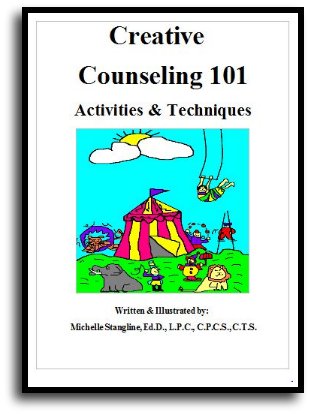
Step By Step Therapy:
Learn how to be a more Creative Therapist with the Book that started it all!
- Graduate School Counseling book used by hundreds of graduate counseling students!
- Includes full color reproducible worksheets with most activities.
- Winner of the Counselor Writer of the Year Award, 2011, Georgia Regional Award
Download Your Copy Today Only $39.95:
See Creative Counseling 101 eBook Information Here:
Get the Set
of all four
eBooks for only $98.95:
An incredible collection of how to do therapy eBooks!
A $159.80 Value,
You Save Over $60!
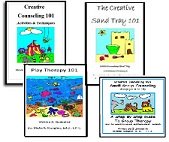
Get your complete set of the Creative Counseling 101.com eBooks by Dr. Michelle Stangline for only $98.95, that's less than $25.00 per eBook (Regular Price is $39.95 for each eBook.).
Your complete set includes:
- Creative Counseling 101
- Creative Group Counseling 101
- Creative Play Therapy 101
- Creative Sand Tray 101
For more information click the link below:
See Complete Set of eBooks For Sale Here:
New!!! "Beyond Art Therapy" 101 eBook
Over 300 pages of Beyond Art Therapy activities and techniques. Learn what I teach graduate counseling students!
See the link below for more information.
Only $39.95
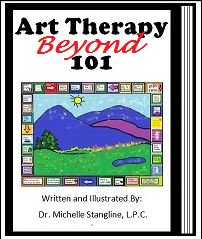
See More Invividual eBooks For Sale:
Sand Tray Therapy 101 eBook:
Learn how to do Sand Tray Therapy or enhance your skills.
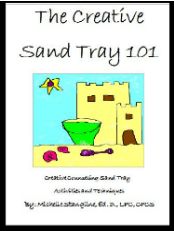
Play Therapy 101 eBook
Learn how to do play therapy or enhance your skills.
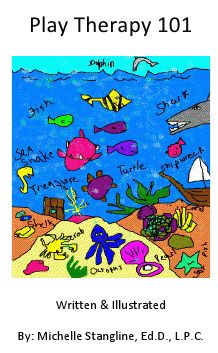
Small Group Counseling eBook For Sale:
Learn how to do creative group therapy and enhance your skills.
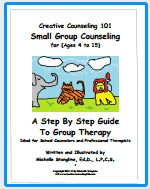
School Counselor Guidance Lesson & Social Stories eBook for sale:
Get a year's worth of school counselor guidance lessons with "Creative Warm & Fuzzy Classroom Guidance Lessons eBook". Introduce your students to the "Warm & Fuzzy Way". Click the link below for more information:
Warm & Fuzzy School Counselor Guidance Lessons eBook
